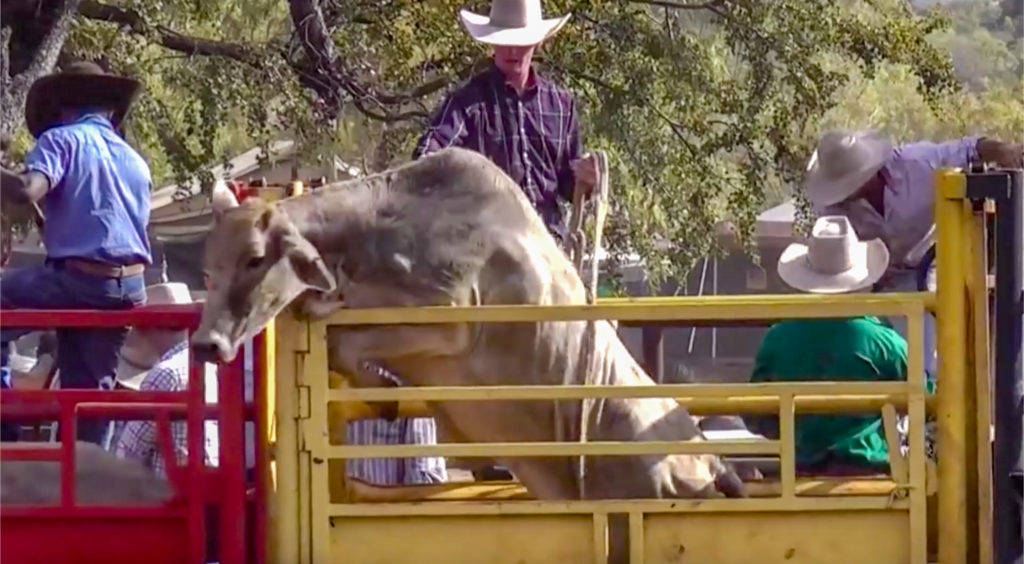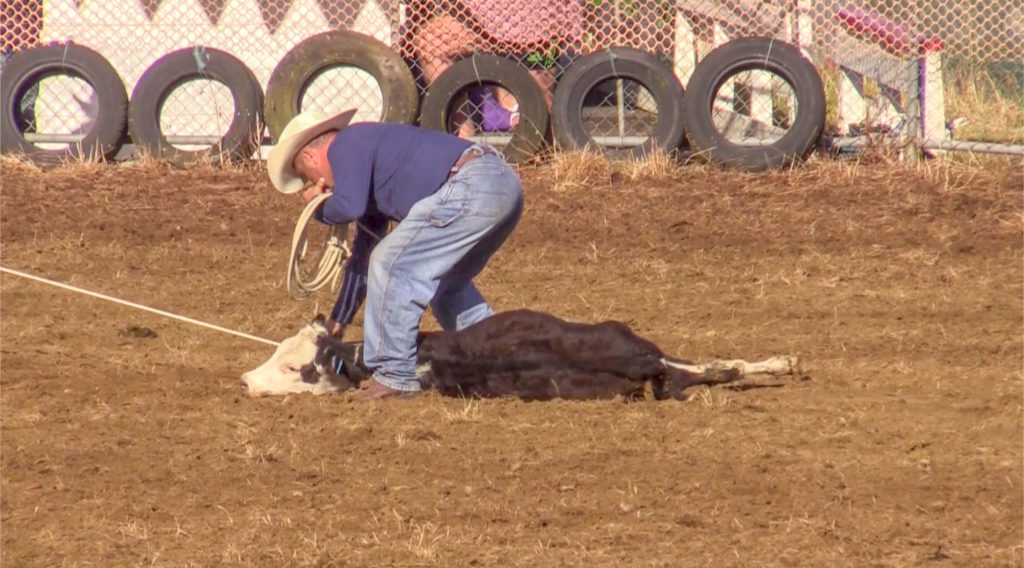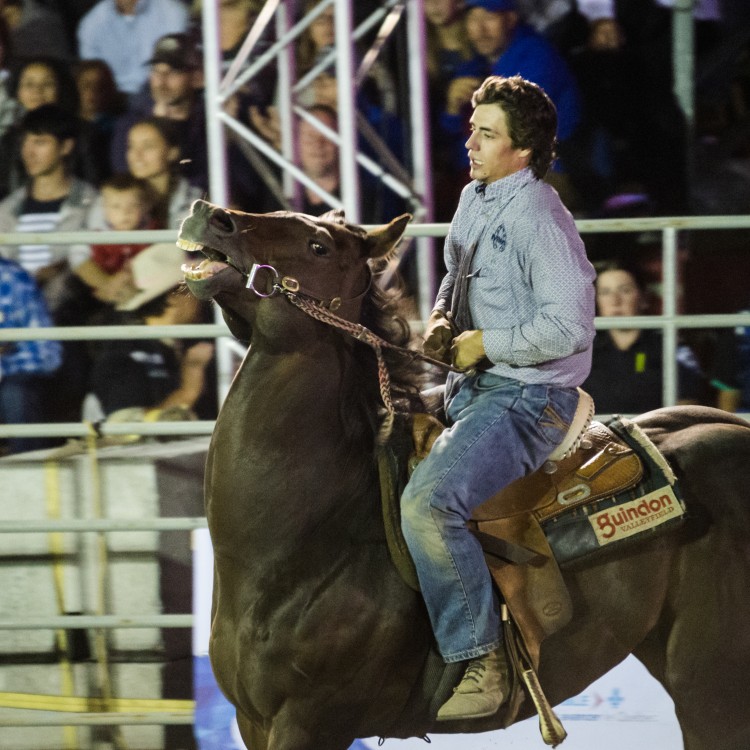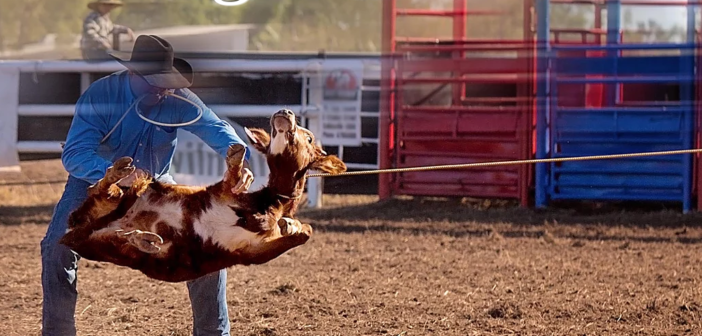Rodeo is a relatively little-discussed animal issue, often largely unknown by those who live outside of the regions where it is most popular. Those who participate in rodeo call it a sport and a valuable tradition, but the animals who are used are routinely physically injured and traumatized. While proponents may act as if animal suffering isn’t central to rodeo, this quote from Keith Martin, current Chairman of the Board, Professional Rodeo Cowboys Association, says it all: “Do I think it hurts the calf? Sure I do. I’m not stupid.”
The upcoming documentary short Bucking Tradition exposes the animal toll of this so-called sport, using a combination of interviews with experts and disturbing footage from rodeos. Directed by Sharon M. Boeckle, the recent grand prize winner of the 2019 International Vegan Film Festival manages to give a compelling and informative overview of this issue in just under nine minutes.
To learn more about the film, what rodeos mean for animals, and the tension between cultural autonomy and animal protection, I had a conversation with Eric Mills, Executive Producer of Bucking Tradition and coordinator of Action for Animals.
Dylan Forest: What is your background with rodeos? How did you get involved with this issue?
Eric Mills: I have been working on rodeo issues since 1986, when I saw a rodeo at the Rowell Ranch rodeo grounds in Castro Valley, California. It was sponsored by the Hayward Police Officers Association as a benefit for the Special Olympics, performed before an audience comprised largely of kids. A horse broke her leg in the holding chute and was down in the arena, unable to rise. Stockhandlers kicked her and used electric prods to get the horse up on three legs, and forced her to hobble out of the arena. No vet was present and she was shot to death about an hour later, apparently with a cop’s gun. Several calves were injured in the break-away calf roping. A final non-sanctioned event involved a team of cowboy/cops attempting to put women’s lace panties on the hind legs of a struggling, bawling steer. Some “sport,” hey?
As I noted at the time to the Police Officers Association and the board of directors at the Hayward Area Recreation & Park District (HARD), which owns the property, “Don’t you find it ironic that officers of the peace should be crippling and abusing animals to help disabled children?” That rodeo was subsequently permanently banned, and I was invited to help draft the HARD rodeo animal welfare policy in 1987, which still stands.
One of the points made in Bucking Tradition is that though the animals used in rodeos are the same species as those used in farming, they are subjected to cruelty that would not be permitted even in a farming setting, particularly the physical brutality. How is it that the animals used in rodeos are not protected from this treatment by animal cruelty laws?
It’s a combination of poor animal cruelty laws, poor enforcement, public ignorance and apathy. Among people who participate, add to that self-deception about How the West Was Won, John Wayne, Western “tradition” and the American flag, all intertwined.
What happens to the animals used in rodeos after the competitions are over, and where do they come from? Are they the same animals that are raised for meat?
The same animals are used over and over. For nearly all, the rodeo arena is merely a detour en route to the slaughterhouse, horses and bulls included. Nearly all end up on the dinner table or in pet food.

Are rodeos essentially traveling shows, like circuses? If so, does that mean that like circuses, the constant transportation between shows is also part of the cruelty involved?
Yes, rodeo animals live lives of near-constant travel, which is both dangerous and stressful for them, and takes a physical and emotional toll. Vet care, food and water are all at the whim of the stock contractors and handlers.
Is rodeo a money making venture at all, or largely a pastime? Is money at all a part of why those doing it don’t want to stop?
Money is a major factor. Unlike most team sports, if a rodeo cowboy doesn’t win, he doesn’t get paid. And it’s really expensive being on the rodeo circuit, what with entrance fees, travel expenses, horse trailers, doctor’s bills, etc. Unlike pro team sports players, very few rodeo cowboys make much money.
Money also plays a big role in the TV coverage, sponsors, advertisers, and various city coffers. Many rodeos donate money to local charities, in a good-will effort. I consider this blood money.
Has there been any progress on protecting the animals used in rodeos in the United States? Are rodeos any more regulated now than they ever were, or is it basically anything goes? Are they shrinking in popularity at all?
Action for Animals sponsored the best rodeo legislation in the United States, back in 1999 (Penal Code 596.7), which set some regulations on rodeos in the state of California. Others should follow suit. There are some 5,000 rodeos held in the U.S. every year. The great majority don’t even require on-site veterinary care. The Professional Rodeo Cowboys Association (PRCA) has done so only since 1995, after five animals died at the California Rodeo in Salinas that year.
Public attitudes toward the use and abuse of animals are changing. Witness the recent demise of the Ringling Bros. Circus; SeaWorld’s phase-out of orca shows; in the past two years New Jersey, Hawaii and California have all banned wild animal acts in circuses; greyhound racing was banned in Florida via a 2018 ballot initiative; and horse racing is under tremendous pressure now, with thousands of deaths on the tracks annually. The rodeo industry is fearful it will be next, which seems more than likely (and I’ll fight for that as long as I have breath in my body).
A number of jurisdictions around the country have banned or seriously restricted rodeos, such as Pittsburgh, PA and Pasadena, CA. Rhode Island has banned calf roping, the Los Angeles City Council is currently considering a ban on all rodeos, and a New York state bill to ban calf roping and flank straps (uncomfortable restraints that are used to encourage horses to buck) is now under consideration for 2020.
People who participate in rodeos claim they love the animals. You often hear a similar thing from farmers who raise animals for meat, or hunters. How do you think someone can simultaneously claim to love animals and also seriously harm them?
Cowboys, they say, “love” the animals, and treat them like family. Hardly! I think they love being around the animals, rather than loving the animals themselves. And they generally confine that limited “love” to the horses and bulls–all of which they name, unlike the steers, cows, calves and sheep, who have no names, and are treated like money on the hoof.
Imagine the public outcry if the rodeo cowboys were to mistreat pet dogs they way they do the roping calves, who are mere babies. The public would not stand for it. Indeed, many stock contractors are critical of calf roping privately, but don’t have the integrity to criticize the event publicly. Again, follow the money.

Sometimes, when there is a sense that people’s traditions and identities are at risk, it can be easier to let go if there is an alternative way to keep the tradition going without the cruelty. Do you know if there have there been any efforts to develop humane rodeos? Is this even possible, or is animal cruelty so foundational that there’s no way to conceive of a rodeo without it?
As Cesar Chavez wisely noted, “Some traditions deserve to die.”
There’s no way in hell to have a “humane” rodeo. That’s a contradiction in terms. As famed animal behaviorist Dr. Temple Grandin noted, “The single worst thing you can do to an animal emotionally is to make it feel afraid. Fear is so bad for animals I think it’s worse than pain.” Be aware that rodeo animals are “prey” animals. As such, they fear for their very lives when roped, ridden, wrestled, chased, jumped on, dragged or otherwise handled roughly. Again, a “humane” rodeo is an impossibility.
It all needs to go. Nearly every animal welfare organization in the U.S., Canada, Australia and New Zealand condemns rodeos due to their inherent cruelty. We need a world-wide ban.
The question often posed on things like rodeos is whether they are cultural heritage or animal abuse. But it seems to me that something can easily be both. In cases like these, the resistance to change seems to be just as much about not wanting to be told what to do by outsiders as it is about actually enjoying and valuing the practice, in this case rodeo. Ideally change would be led from the inside, but that’s just not always going to happen, unfortunately. What are your thoughts on this tension between cultural autonomy and animal protection?

A practice can be “cultural heritage” and abuse at the same time, and rodeo surely is. As a native Southerner, I come from a long line of such “traditions”: slavery, dogfighting, cockfighting, spousal abuse, incest,
and so on. I have a statement from an 18-year-old rodeo queen, saying “What me and my rodeo friends really hate are Democrats, environmentalists and gays.” Lovely. As it happens, I fall into all three of those categories. I’ll give you three guesses whom most of the people in rodeos voted for in 2016…
I think the Dalai Lama had it right: “Our main purpose in life is to help others. And if you can’t help them, at least do them no harm.” And certainly do no harm in the name of so-called entertainment and a pseudo-“sport.” Real sport involves willing, evenly-matched participants. Rodeo does not qualify.
What needs to be done to make progress on this issue? What do you see as the ideal next step? How do you think should people be focusing on making change?
Public education. It never ceases to amaze me that anyone could witness the calf roping event and not be moved to action. Legislation should be introduced in every county and state every year until this cruelty is abolished. The United Kingdom outlawed rodeos back in 1934. Animal advocates should be writing letters, running display ads and billboards, writing commentaries for the media, and attempting ballot initiatives to stop the cruelty at both the county and state levels. Meanwhile, boycott all rodeos and their corporate sponsors and advertisers.
Perhaps Tom Hirsig, the CEO of Cheyenne Frontier Days Rodeo, said it best: “If it gets to the point where people think rodeo is inhumane or cruel, they quit coming, and then we’re out of business.”
Featured image: a calf is yanked by their neck through the air during a calf roping event. Image credit Bucking Tradition.






3 Comments
Many thanks to Dylan Forest and ANIMAL PEOPLE FORUM for helping to bring rodeo issues to the fore. America seems on the brink of a sea change regarding public attitudes about the use of animals in so-called “entertainment.” Witness the recent ban on orca shows at SeaWorld, the demise of the Ringling Bros. Circus; bans on wild animal acts in Hawaii, New Jersey & California; 2018 ban on greyhound racing in Florida via ballot initiative; the current controversy over horse racing, with 2,000+ fatalities on American tracks every year….Could rodeo be next? Only this week (October 29), the Alameda County Board of Supervisors in California passed a ban on the rodeo’s popular “mutton busting” event, in which young children, often in tears, are coerced into riding terrified sheep, dangerous for all concerned. Here’s hoping others will follow suit.
Legislation should be submitted every year in every state to outlaw rodeo’s inherent cruelties. Most legislators decide in November upon which bills to carry the following year. So let your reps hear from you! Now’s the time. Thanks for caring.
Here is the reality of rodeo: Rodeo is an archaic form of entertainment that results in the injuries and deaths of rodeo animals. Several were killed in rodeos this year, and several also died last year.
It is difficult to determine the number as these deaths and injuries are often not reported. One horse’s death went unreported until a rodeo insider revealed its death.
Roping calves causes hidden injuries. Dr Robert Bay, a veterinarian from Colorado, euthanized several roping calves to study their injuries. He found hemorrhage, torn ligaments and cartilage, torn and bruised muscles, damaged trachea and damaged thyroid glands in the neck.
Meat inspectors Charles Haber and Robert Fetzner found multiple damages in rodeo steers at slaughter plants near Cheyenne, Wyoming.
These injuries included broken bones, torn muscles, damaged ligamentum nuchae in the neck, damaged internal organs and blood in the peritoneal cavity.
These animals obviously were in extreme pain before they were killed.
Horses and bulls risk broken bones from bucking beyond their normal bucking patterns. The flank strap and spurs cause the extreme bucking.
If you want to have a rodeo based on normal animal behaviour, stop the calf-roping, get rid of the spurs and ban the flank strap. Without these devices, animals will no longer be injured or die in the arena.
PEGGY W LARSON DVM MS JD (former bareback bronc rider and former large animal veterinarian who treated rodeo animals).
Thank you for this excellent piece and for giving Eric Mills the recognition he has earned. Eric has done more to help animals abused in rodeo than just about anyone. I agree with him: It’s time for rodeo to die.